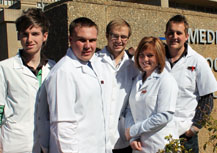 |
|
Michael van Niekerk, Christiaan Nel and Carika Stols participated in the School for Neurosciences.
26 July 2012
|
For five students from the Faculty of Health Sciences at the University of the Free State, the winter holidays were no time to rest; they attended a summer school for medical students in Groningen in The Netherlands.
Michael van Niekerk, Marcel Nel, Henk Kruger, Christiaan Nel and Carika Stols are all undergraduate medical students who expanded their skills and knowledge during the summer school.
The University of Groningen’s Medical School offers an annual Summer School Programme at the University Medical Centre in Groningen.
It is the largest hospital in the province of Groningen in The Netherlands and offers highly specialised health services to The Netherlands and to the northern parts of Germany.
Hordes of students from around the world annually apply for attendance of the school. A panel invites eligible candidates from the applications to participate in the school. The students are then divided into four different schools, namely Paediatrics, Neurosciences, Global Health and Oncology.
“Besides acquiring better skills and knowledge, the schools also provide us the opportunity to exchange experience and knowledge with participants from other countries. We had regular conversations with students from Korea, Indonesia, Mexico, Brasilia, the Czech Republic, Portugal, Egypt, Belgium, Italy and Spain, on the difference between the medical systems and cultures of the various countries,” says Henk Kruger, who, together with Marcel Nel, participated in the School for Paediatrics.